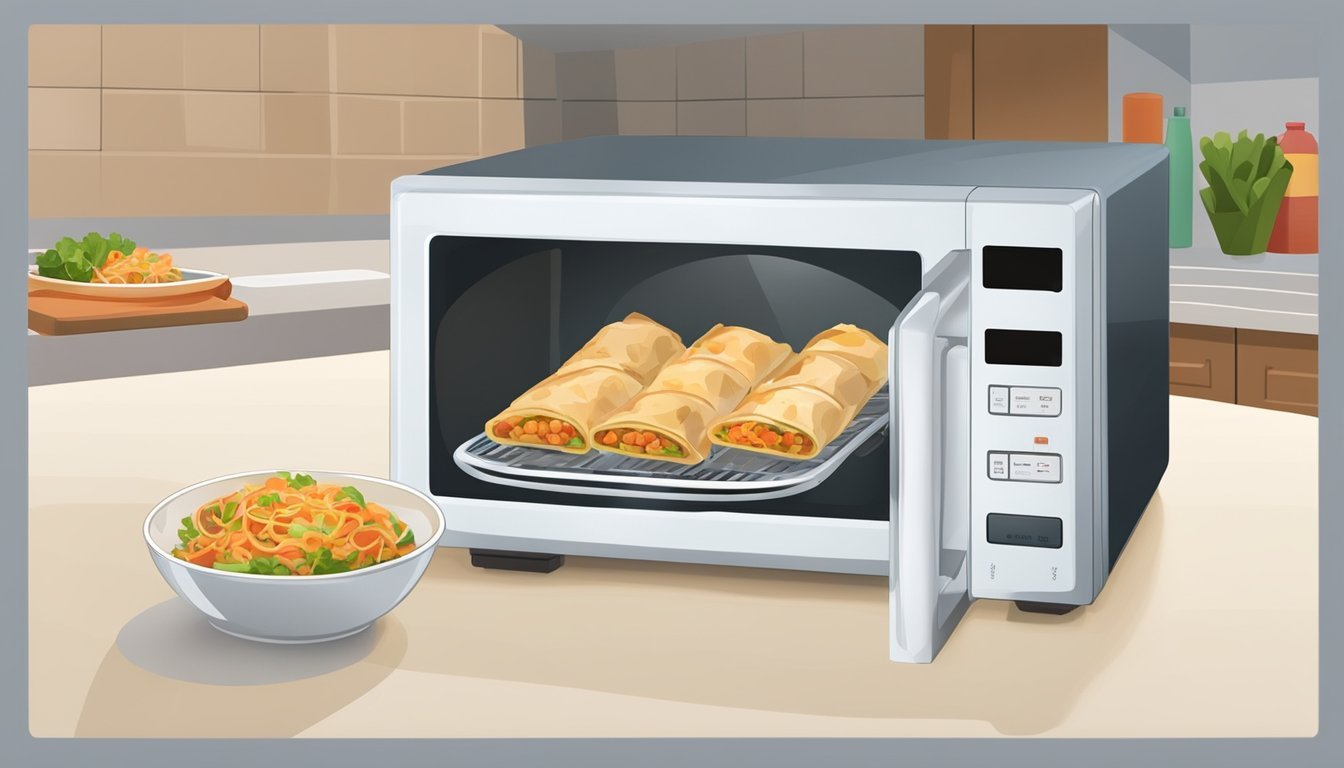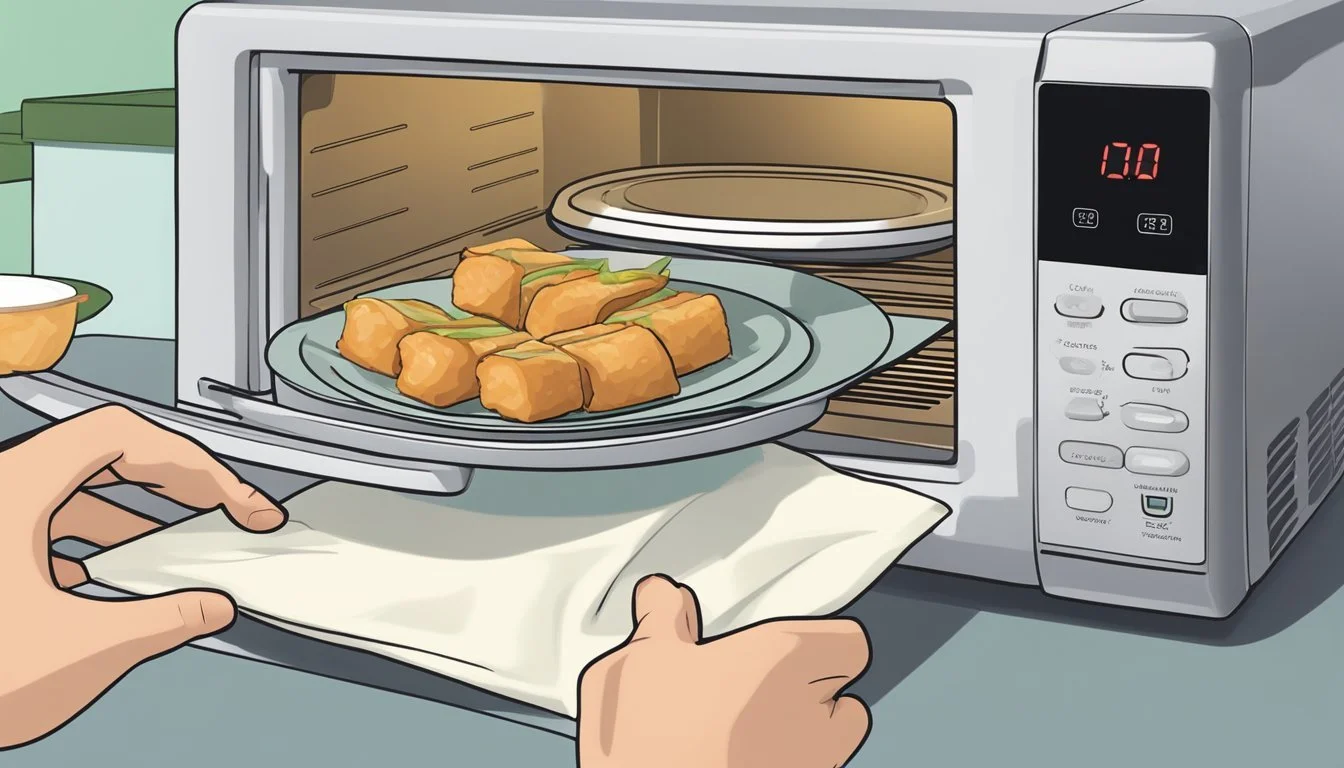How to Reheat Gluten-Free Spring Rolls
Best Methods and Tips
Gluten-free spring rolls can be a delightful snack or appetizer, but reheating them to maintain their crispy texture can be challenging. The best way to reheat gluten-free spring rolls while keeping them crispy is by using a pan or an oven. This method ensures the rolls are heated evenly without becoming soggy.
For those who prefer a quicker method, using an air fryer is also highly effective. It’s essential to set the correct temperature to avoid overcooking or burning the spring rolls. Additionally, similar results can be achieved by carefully frying them in hot oil, maintaining the perfect balance of heat and crispiness.
Experimenting with these methods will help you achieve the ideal results, ensuring your gluten-free spring rolls are just as delicious as when they were freshly made.
Understanding Gluten-Free Spring Rolls
When preparing gluten-free spring rolls, it's essential to know about the correct ingredients and how they differ from other similar appetizers like egg rolls. This ensures that the dish is both safe for consumption and true to its culinary style.
Identifying Gluten-Free Ingredients
The primary ingredient for gluten-free spring rolls is rice paper, which is naturally gluten-free. Traditional wheat-based wrappers are not suitable for those requiring a gluten-free diet. Additionally, ensure fillings such as vegetables, meats, and seafood are free from gluten-containing marinades or sauces.
Using gluten-free tamari or coconut aminos is a great alternative to soy sauce, which typically contains gluten. Always check labels for certifications ensuring that products are gluten-free to avoid contamination. Finely diced vegetables, tofu, or seasoned meat are common fillings, providing a fresh and flavorful bite.
Differences Between Spring Rolls and Egg Rolls
Spring rolls use thin rice paper wrappers, giving them a delicate and crispy texture when fried or a soft bite when fresh. They often feature fresh or lightly cooked fillings like shrimp, vegetables, or chicken.
In contrast, egg rolls usually have a thicker, wheat-based wrapper and often include a more robust filling with ingredients like pork, cabbage, and sometimes glass noodles. The thicker wrapper of egg rolls results in a chewier texture once cooked, whereas spring rolls emphasize a lighter, crisper experience.
Ultimately, understanding these differences is crucial for selecting the right recipe and ensuring that the final dish is true to its intended culinary origin and safe for those with gluten sensitivities.
Ingredients and Alternatives
To reheat gluten-free spring rolls successfully, it's essential to choose the right fillings, gluten-free wrappers, and dipping sauces. These components will ensure the rolls are both delicious and suitable for dietary needs.
Choosing the Right Fillings
Selecting the appropriate fillings is crucial for taste and texture. Vegetables such as cabbage, carrots, onions, and bean sprouts offer a crunchy bite and pair well with other ingredients. Tofu or mushrooms can add a protein element, making the rolls more filling.
Garlic and soy sauce (or tamari for a gluten-free alternative) provide robust flavor. Fresh cilantro adds a refreshing note, enhancing the overall taste.
Gluten-Free Wrappers Selection
For gluten-free spring rolls, rice paper wrappers are the most common choice. These wrappers are made from rice flour and water, making them naturally free of gluten. They are also light and easy to handle.
To prepare, dip a sheet of rice paper in warm water for about 5 seconds until it softens. Then, place it on a wooden or plastic surface for rolling. Glass noodles can also be included in the filling to add texture.
Gluten-Free Dipping Sauce Varieties
A good dipping sauce completes the spring roll experience. Peanut sauce is a popular option, offering a rich and nutty flavor. Use gluten-free soy sauce or tamari as the base, mixed with peanut butter, garlic, and a bit of sweet chili sauce for sweetness.
Sweet chili sauce on its own is another excellent choice, providing a perfect balance of sweet and spicy. Additionally, a simple blend of soy sauce, vinegar, and a hint of garlic can make a versatile and quick-to-prepare dipping sauce.
Preparation of Gluten-Free Spring Rolls
Creating gluten-free spring rolls involves assembling fresh ingredients and mastering the technique of rolling rice paper wrappers.
Assembling the Spring Rolls
Start with gluten-free rice paper wrappers, which can be found in most grocery stores. Rice paper is essential as it provides the gluten-free base for the spring roll. There's a variety of fillings you can use, but popular choices include a mix of vegetables, proteins like tofu or shrimp, and fresh herbs.
Prepare the filling by slicing vegetables thinly. Carrots, cucumbers, and bell peppers are excellent choices. For a vegan option, add tofu or edamame for protein. Cook any proteins beforehand and let them cool. Lay out ingredients in an accessible way, as assembly needs to be quick and efficient.
The Art of Rolling with Rice Paper
To begin rolling, soak each rice paper wrapper in warm water for about 15 seconds until soft but not too mushy. Lay the softened rice paper on a clean surface and start placing your filling in the bottom third of the wrapper.
Fold the sides over the filling and then tightly roll the paper away from you. Use a bit of water if necessary to seal the end. Practice makes perfect, so don’t worry if the first few aren’t perfect. Repeat the process until all your fillings are used up.
By ensuring each spring roll is tightly packed and sealed well, you'll keep ingredients intact and enhance the eating experience.
Cooking Methods
Reheating gluten-free spring rolls can be done through baking or frying. Each method has distinct benefits, whether aiming for a healthier option or a crispy texture.
Baking for Healthier Option
Baking is an excellent choice for those looking to maintain a healthier diet. Preheat the oven to 350°F (180°C). Line a baking sheet with parchment paper to prevent sticking. Arrange the spring rolls in a single layer on the baking sheet.
Insert the baking sheet into the preheated oven. Bake the spring rolls for 15-20 minutes, turning them halfway through to ensure even heating. This method keeps oil usage minimal while allowing the spring rolls to heat evenly. The result is a crispy exterior without excess oil.
Frying for Crispy Texture
For a crispy texture, frying is the best option. Using a pot or deep fryer, heat vegetable oil or canola oil to 350°F (180°C). Carefully place 1-2 spring rolls into the hot oil at a time. Fry for about 30-45 seconds until they turn a golden brown.
Remove the spring rolls and let them rest on a paper towel for 60 seconds to absorb any excess oil. This method creates a perfectly crispy texture but involves using more oil compared to baking. It’s ideal for those desiring a traditional, crispy bite.
Storing Gluten-Free Spring Rolls
Proper storage ensures your gluten-free spring rolls maintain their texture and flavor. Knowing the best methods for freezing and refrigerating helps extend their shelf life.
Properly Freezing Cooked Spring Rolls
To freeze cooked gluten-free spring rolls, first allow them to cool to room temperature. Lay them out in a single layer on a baking sheet lined with parchment paper. Place the baking sheet in the freezer for about 1-2 hours to pre-freeze them.
Once solid, transfer the spring rolls to a resealable freezer bag or an airtight container. This method prevents them from sticking together. Label the container with the date and contents for easy reference. Frozen spring rolls can last up to 2 months without significant loss of quality.
When ready to reheat, take out the desired amount and either reheat them directly in an oven preheated to 375°F (190°C) or use an air fryer. There’s no need to thaw them before reheating. This keeps the spring rolls crispy and delicious.
Refrigeration Guidelines
For short-term storage, refrigerate the spring rolls. First, wrap each spring roll in parchment paper to minimize exposure to moisture, which can make them soggy. Place the wrapped spring rolls in an airtight container or a resealable plastic bag.
Store them in the refrigerator for up to 3 days. This method keeps the spring rolls fresh and prevents them from drying out. When it’s time to eat, reheat them using an oven or an air fryer set to 375°F (190°C) until heated through.
Avoid microwaving as it can result in a less crispy texture. By following these guidelines, you can enjoy your gluten-free spring rolls tasting as fresh as the day they were made.
Reheating Gluten-Free Spring Rolls
Properly reheating gluten-free spring rolls involves maintaining their crispy texture while ensuring they are thoroughly warmed. The methods below address using an oven, microwave, and pan-frying.
Oven Reheating Instructions
Preheat the oven to 350°F (175°C).
Place the spring rolls on a wire rack or a preheated baking tray. Using a wire rack allows heat to circulate, ensuring even reheating. Arrange the spring rolls in a single layer, avoiding any overlap. This prevents them from becoming soggy.
Heat the spring rolls for 15-20 minutes. Check their color periodically to avoid over-browning.
If necessary, flip them halfway using a spatula. Removing them while still slightly soft ensures they finish crisping up out of the oven.
Microwave Reheating Technique
Use a microwave-safe plate and line it with a paper towel. This absorbs moisture and helps maintain crispiness.
Place the spring rolls on the plate in a single layer, ensuring they do not touch.
Heat on medium power for 30-second intervals. Check the spring rolls after each interval to avoid overcooking.
Continue until they are heated through. Although the microwave is quick, it may not keep the rolls as crispy as other methods.
Pan-Frying to Reheat
Heat a small amount of oil in a frying pan over medium-high heat.
Once the oil is hot and shimmering, place the spring rolls in the pan. Do this in batches if necessary, avoiding overcrowding.
Fry each side for around 1-2 minutes or until they turn golden brown and crispy. Use a spatula to flip them gently, preventing the release of hot air which can make them soggy.
After reheating, place the spring rolls on a paper towel to drain excess oil and retain their crispy texture.
Serving Suggestions
Enhance the gluten-free spring roll experience by pairing them with complementary sides and sauces and by using presentation techniques to make them visually appealing.
Pairing with Sides and Sauces
Gluten-free spring rolls pair wonderfully with a variety of sides and dipping sauces. A fresh salad made with crisp lettuce, thinly sliced cucumbers, and julienned carrots provides a refreshing contrast.
For an extra layer of flavor, offer dipping sauces such as sweet chili, hoisin, or peanut sauce. These sauces can enhance the taste of the spring rolls and provide a delightful dipping experience.
Consider including small bowls of pickled vegetables alongside. This adds a tangy element and balances the rich flavors of the spring rolls.
Presentation and Garnishing Tips
Presentation can elevate the appeal of gluten-free spring rolls. Arrange the spring rolls on a platter lined with lettuce leaves. This not only keeps them from sticking but also adds a pop of color.
Garnish the platter with thinly sliced cucumbers, shredded carrots, and fresh mint or cilantro leaves. These garnishes add a touch of freshness and vibrant color.
Placing small bowls of dipping sauce around the platter makes it easy for guests to enjoy without creating a mess.
For a more upscale presentation, serve each spring roll individually on a small plate with a drizzle of dipping sauce and a sprig of fresh herbs.
Health and Dietary Considerations
When reheating gluten-free spring rolls, it's essential to consider nutritional values and dietary restrictions to ensure a balanced and safe meal. This section will delve into the calorie content, nutritional makeup, and gluten-free dietary restrictions.
Calorie and Nutritional Information
Gluten-free spring rolls can vary in calorie content depending on the ingredients used. Typically, the calorie count for vegetable spring rolls ranges from 70 to 100 calories per roll. This number can increase with additional proteins like tofu or shrimp.
A standard gluten-free spring roll includes various vegetables such as carrots, cucumbers, and bell peppers. These components contribute to a meal rich in vitamins A and C, fiber, and antioxidants.
For those monitoring macronutrients, a typical roll contains about:
2-3 grams of protein (more if protein is added)
2-4 grams of fat (depending on whether it’s fried or fresh)
15-20 grams of carbohydrates
Ingredients are crucial. Using organic or locally sourced vegetables can enhance the nutritional profile. Opting for low-sodium soy sauce or a dairy-free dipping sauce like peanut or tahini can also make the dish healthier.
Understanding Gluten-Free Dietary Restrictions
Individuals on a gluten-free diet avoid gluten, a protein found in wheat, barley, and rye. Gluten intolerance or celiac disease can cause severe reactions, including digestive issues and nutrient absorption problems.
Using rice paper wrappers ensures the spring rolls are gluten-free. It's vital to confirm that all other ingredients, including sauces and seasonings, are free from gluten contamination.
For additional dietary needs, spring rolls can easily be made vegetarian or vegan. Simply exclude any animal-based proteins and utilize tofu or additional vegetables. Selecting dairy-free sauces ensures the dish suits those with dairy sensitivities.
Ensuring these dietary considerations are met will provide a satisfying and safe dish for those with specific health needs. By carefully selecting and preparing ingredients, gluten-free spring rolls can be a nutritious and inclusive meal option.
Additional Gluten-Free Spring Roll Resources
For those looking to deepen their culinary skills in making gluten-free spring rolls, several online resources provide comprehensive guides, recipes, and tips.
Gluten-Free Recipe Blogs and Websites
Dedicated culinary blogs and gluten-free websites are an excellent source of information. Sites like The VGN Way often include step-by-step instructions for Vietnamese spring rolls.
Amazing hot-tip: Some blogs will include a recipe card for easy printing and referencing in the kitchen.
Another popular blog, What To Cook Today, offers detailed explanations on making homemade spring rolls from scratch, including tips on choosing gluten-free wrappers from Asian markets.
For a variety of styles and flavors, explore My Gluten Free Kitchen, which often incorporates dairy-free and low FODMAP recipes, ensuring a wide range of dietary needs are met.
These blogs and websites provide invaluable resources for creating delicious and diverse gluten-free spring rolls at home.







